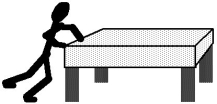Multiple Choice
 Mary pushes horizontally on a large, heavy table, which is standing alone in the middle of a room, and notes that the table does not move despite the fact that she is pushing on it (see the figure) . Why doesn't the table move?
Mary pushes horizontally on a large, heavy table, which is standing alone in the middle of a room, and notes that the table does not move despite the fact that she is pushing on it (see the figure) . Why doesn't the table move?
A) The table had so much mass that its inertia kept it from moving.
B) Although it is true that forces cause accelerations, they do not cause velocities; therefore, the table acquired no velocity.
C) Newton's law of force pairs says that there is an opposite "reaction force" by the table against the instructor's hand, and this reaction force keeps the table from moving.
D) Frictional forces by the floor on the table legs acted in the opposite direction to produce a net force of zero.
E) According to Newton's meaning of the word "force," the horizontal push against the table was not really a force.
Correct Answer:

Verified
Correct Answer:
Verified
Q2: Regarding the relation between acceleration, force, and
Q3: Jet planes operate by<br>A) magic.<br>B) sucking in
Q4: You push your 2 kg physics book
Q5: Suppose that we wish to find the
Q6: When you pull an object, such as
Q7: An apple weighing 3 newtons hangs, motionless,
Q8: A "force" could be best described as<br>A)
Q9: The "drive force" that pushes a car
Q10: You hold a 2 newton apple, having
Q11: A 39- kg girl standing at rest